Spatiotemporal Dynamics of Beijing’s Urbanization Efficiency from 2005 to 2014
Abstract
:1. Introduction
2. Study Area
3. Data and Methodology
3.1. Data
3.2. Index System
3.3. Methodology
3.3.1. DEA Model
3.3.2. Malmquist TFP Index
3.4. Getis–Ord General Index
4. Results and Discussion
4.1. Comparison of Beijing’s Urbanization Efficiency and Economic Growth Rate for the Period 2005–2014
4.2. Spatial Pattern of Total Factor Urbanization Efficiency in Beijing
4.3. Static Measurement of Beijing’s Urbanization Efficiency in 2014
5. Conclusions
Acknowledgments
Author Contributions
Conflicts of Interest
References
- He, C.; Okada, N.; Zhang, Q.; Shi, P.; Zhang, J. Modeling urban expansion scenarios by coupling cellular automata model and system dynamic model in Beijing, China. Appl. Geogr. 2006, 26, 323–345. [Google Scholar] [CrossRef]
- Song, W.; Deng, X. Effects of urbanization-induced cultivated land loss on ecosystem services in the North China Plain. Energies 2015, 8, 5678–5693. [Google Scholar] [CrossRef]
- Wang, S.J.; Ma, H.; Zhao, Y.B. Exploring the relationship between urbanization and the eco-environment—A case study of Beijing–Tianjin–Hebei region. Ecol. Indic. 2014, 45, 171–183. [Google Scholar] [CrossRef]
- Yin, K.; Wang, R.; An, Q.; Yao, L.; Liang, J. Using eco-efficiency as an indicator for sustainable urban development: A case study of Chinese provincial capital cities. Ecol. Indic. 2014, 36, 665–671. [Google Scholar] [CrossRef]
- CBS (National Bureau of Statistics of China). China Statistical Yearbook; Chinese Statistics Press: Beijing, China, 2016.
- Zhao, P. Managing urban growth in a transforming China: Evidence from Beijing. Land Use Policy 2011, 28, 96–109. [Google Scholar] [CrossRef]
- Li, Y.; Li, Y.; Zhou, Y.; Shi, Y.; Zhu, X. Investigation of a coupling model of coordination between urbanization and the environment. J. Environ. Manag. 2012, 98, 127. [Google Scholar] [CrossRef] [PubMed]
- Charnes, A.; Cooper, W.W.; Li, S. Using DEA to evaluate relative efficiencies in the economic performance of Chinese cities. Soc-Econ. Plan. Sci. 1989, 23, 325–344. [Google Scholar] [CrossRef]
- Abdelfattah, B.M.; Ablanedorosas, J.H.; Gemoets, L.A. Developing country efficiency assessment by means of a comprehensive model based on data envelopment analysis. Int. J. Soc. Syst. Sci. 2011, 3, 58–80. [Google Scholar] [CrossRef]
- Morais, P.; Camanho, A.S. Evaluation of performance of European cities with the aim to promote quality of life improvements. Omega 2011, 39, 398–409. [Google Scholar] [CrossRef]
- Storto, C.L. Ecological efficiency based ranking of cities: A combined DEA cross-efficiency and Shannon’s Entropy method. Sustainability 2016, 8, 124. [Google Scholar] [CrossRef]
- Bernard, J.; Cantner, U. French regional performance and variety—A non-parametric frontier approach. In La Methode DEA—Analyse Des Performance; Badillo, P.Y., Paradi, J.C., Eds.; Hermes Science Publications: Paris, France, 1999; pp. 255–273. [Google Scholar]
- Mas, M.; Maudos, J.; Pérez, F.; Uriel, E. Public capital, productive efficiency and convergence in the spanish regions (1964–1993). Rev. Income Wealth 2010, 44, 383–396. [Google Scholar] [CrossRef] [Green Version]
- Chen, Y.; Chen, Z.; Xu, G.; Tian, Z. Built-up land efficiency in urban China: Insights from the General Land Use Plan (2006–2020). Habitat Int. 2016, 51, 31–38. [Google Scholar] [CrossRef]
- He, J.; Wan, Y.; Feng, L.; Ai, J.; Wang, Y. An integrated data envelopment analysis and emergy-based ecological footprint methodology in evaluating sustainable development, a case study of Jiangsu Province, China. Ecol. Indic. 2016, 70, 23–34. [Google Scholar] [CrossRef]
- Liu, Y.; Wang, W.; Li, X.; Zhang, G. Eco-efficiency of urban material metabolism: A case study in Xiamen, China. Int. J. Sustain. Dev. World 2010, 17, 142–148. [Google Scholar] [CrossRef]
- Brülhart, M.; Mathys, N.A. Sectoral agglomeration economies in a panel of European regions. Region. Sci. Urban Econ. 2008, 38, 348–362. [Google Scholar] [CrossRef]
- Chen, S.; Zhang, S. Large-scale land use for construction and energy consumption after the new millennium with their impact on total-factor efficiency change in China’s regional economy. Energies 2014, 7, 1986–2003. [Google Scholar] [CrossRef]
- Halleux, J.M.; Marcinczak, S.; Krabben, E.V.D. The adaptive efficiency of land use planning measured by the control of urban sprawl. The cases of the Netherlands, Belgium and Poland. Land Use Policy 2012, 29, 887–898. [Google Scholar] [CrossRef]
- Yang, W.C.; Lee, Y.M.; Hu, J.L. Urban sustainability assessment of Taiwan based on data envelopment analysis. Renew. Sustain. Energ. Rev. 2016, 61, 341–353. [Google Scholar] [CrossRef]
- Deilmann, C.; Lehmann, I.; Reißmann, D.; Hennersdorf, J. Data envelopment analysis of cities—Investigation of the ecological and economic efficiency of cities using a benchmarking concept from production management. Ecol. Indic. 2016, 67, 798–806. [Google Scholar] [CrossRef]
- Rosenzweig, C.; Solecki, W.; Hammer, S.A.; Mehrotra, S. Cities lead the way in climate change action. Nature 2010, 467, 909–911. [Google Scholar] [CrossRef] [PubMed]
- Iftikhar, Y.; He, W.; Wang, Z. Energy and CO2 emissions efficiency of major economies: A non-parametric analysis. J. Clean. Prod. 2016, 139, 779–787. [Google Scholar] [CrossRef]
- Zanon, B.D.B.; Roeffen, B.; Czapiewska, K.M.; de Graaf-Van Dinther, R.E.; Mooij, P.R. Potential of floating production for delta and coastal cities. J. Clean. Prod. 2017, 151, 10–20. [Google Scholar] [CrossRef]
- Franco, S.; Mandla, V.R.; Rao, K.R.M. Urbanization, energy consumption and emissions in the Indian context A review. Renew. Sustain. Energ. Rev. 2017, 71, 898–907. [Google Scholar] [CrossRef]
- Zhang, N.; Choi, Y. A note on the evolution of directional distance function and its development in energy and environmental studies 1997–2013. Renew. Sustain. Energ. Rev. 2014, 33, 50–59. [Google Scholar] [CrossRef]
- Yang, Z.; Cai, J.; Ottens, H.F.L.; Sliuzas, R. Beijing. Cities 2013, 31, 491–506. [Google Scholar] [CrossRef]
- Zhao, P. Too complex to be managed? New trends in peri-urbanisation and its planning in Beijing. Cities 2013, 30, 68–76. [Google Scholar] [CrossRef]
- Henderson, J.V. Cities and development. J. Regional. Sci. 2010, 50, 515–540. [Google Scholar] [CrossRef] [PubMed]
- Grimm, N.B.; Faeth, S.H.; Golubiewski, N.E.; Redman, C.L.; Wu, J.; Bai, X.; Briggs, J.M. Global change and the ecology of cities. Science 2008, 319, 756–760. [Google Scholar] [CrossRef] [PubMed]
- Charnes, A.; Cooper, W.W.; Rhodes, E. Measuring the efficiency of decision making units. Eur. J. Oper. Res. 1978, 2, 429–444. [Google Scholar] [CrossRef]
- Caves, D.W.; Christensen, L.R.; Diewert, W.E. Multilateral comparisons of output, input, and productivity using superlative index numbers. Econ. J. 1982, 92, 73–86. [Google Scholar] [CrossRef]
- Getis, A.; Ord, J.K. The Analysis of Spatial Association by Use of Distance Statistics; Springer: Berlin/Heidelberg, Germany, 2010; pp. 127–145. [Google Scholar]
- Zhao, J.; Chai, L. A novel approach for urbanization level evaluation based on information entropy principle: A case of Beijing. Physica A 2015, 430, 114–125. [Google Scholar] [CrossRef]
- Qi, W.; Deng, X.; Chu, X.; Zhao, C.; Zhang, F. Emergy analysis on urban metabolism by counties in Beijing. Phys. Chem. Earth Parts A/B/C 2017. [Google Scholar] [CrossRef]
- Zhang, L.; Zhao, S.X. City branding and the Olympic effect: A case study of Beijing. Cities 2009, 26, 245–254. [Google Scholar] [CrossRef]
- Fang, C.L.; Guan, X.L.; Lu, S.S.; Min, Z.; Yu, D. Input–Output efficiency of urban agglomerations in China: An application of data envelopment analysis (DEA). Urban Stud. 2013, 50, 2766–2790. [Google Scholar] [CrossRef]
- Lobo, J.; Bettencourt, L.M.A.; Strumsky, D.; West, G.B. Urban scaling and the production function for cities. PLoS ONE 2013, 8, e58407. [Google Scholar] [CrossRef] [PubMed]

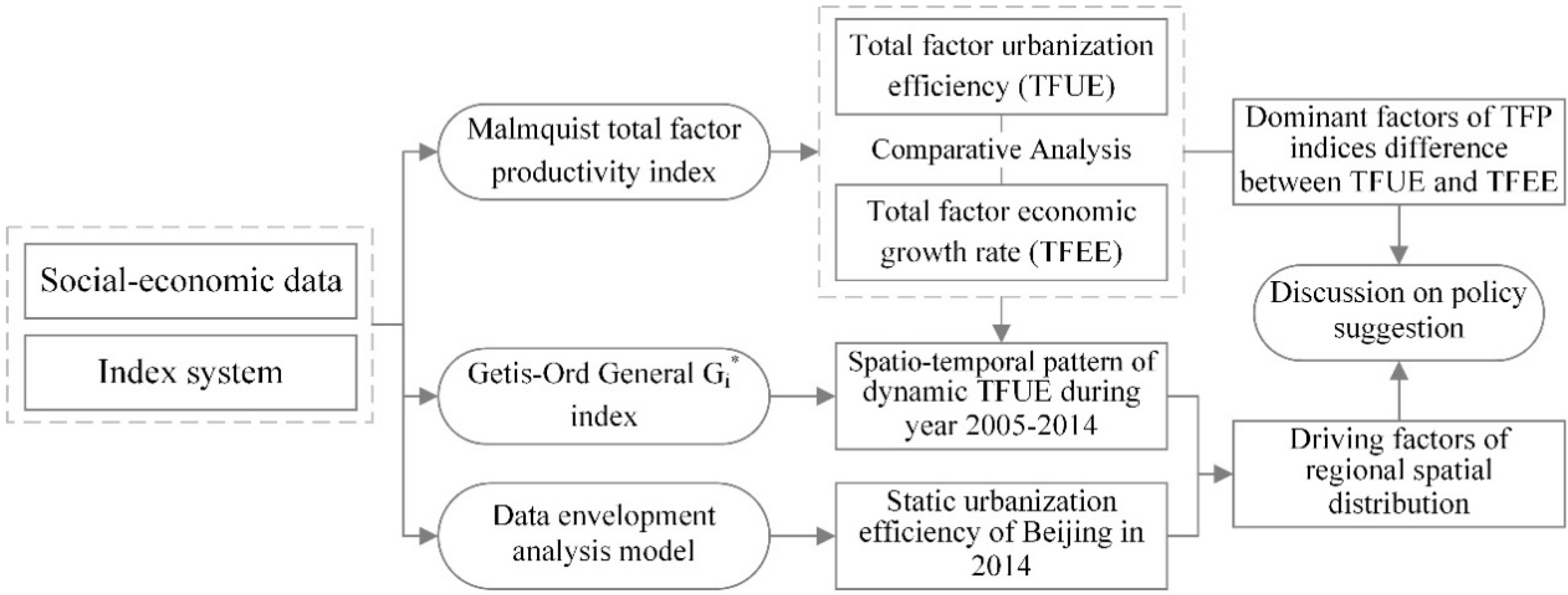
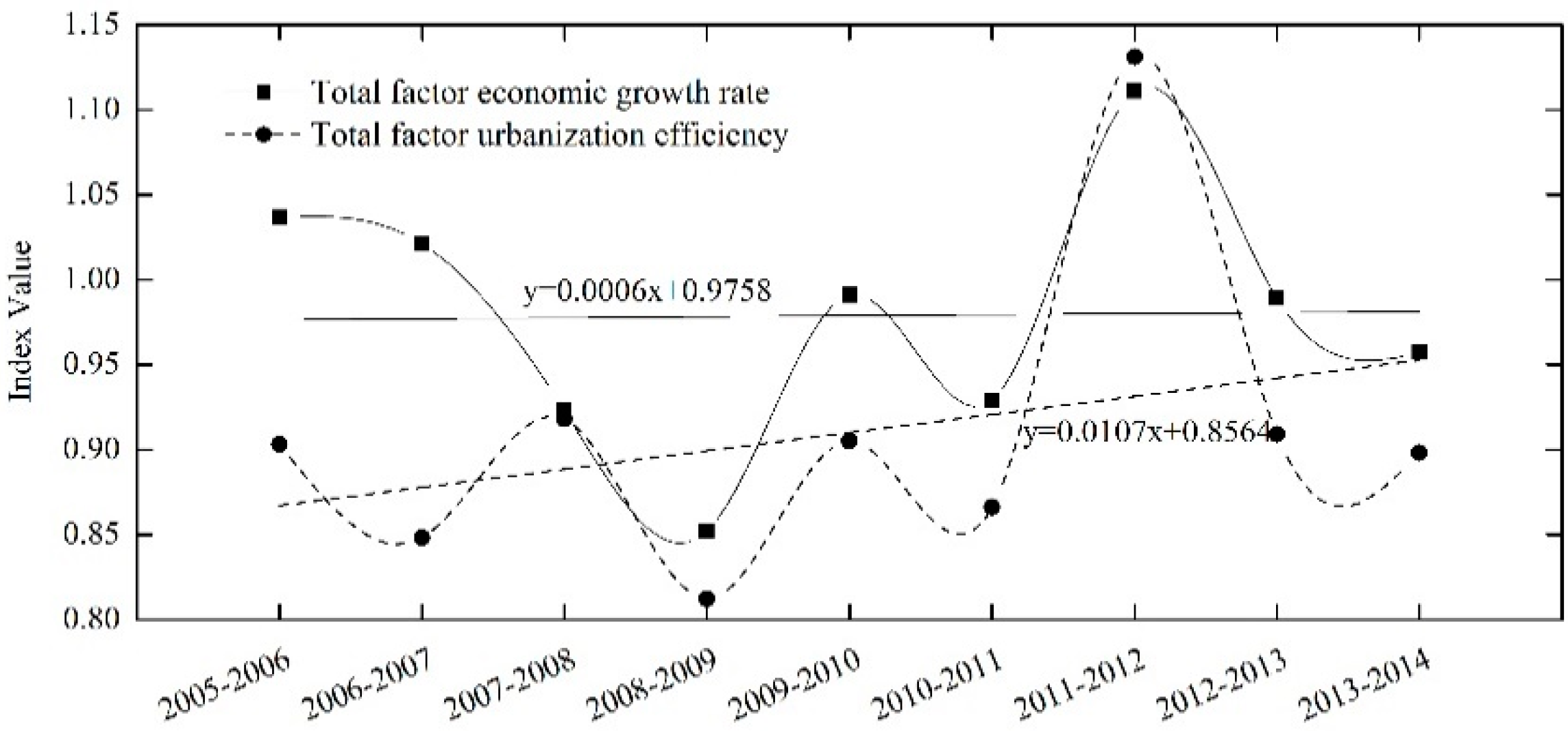

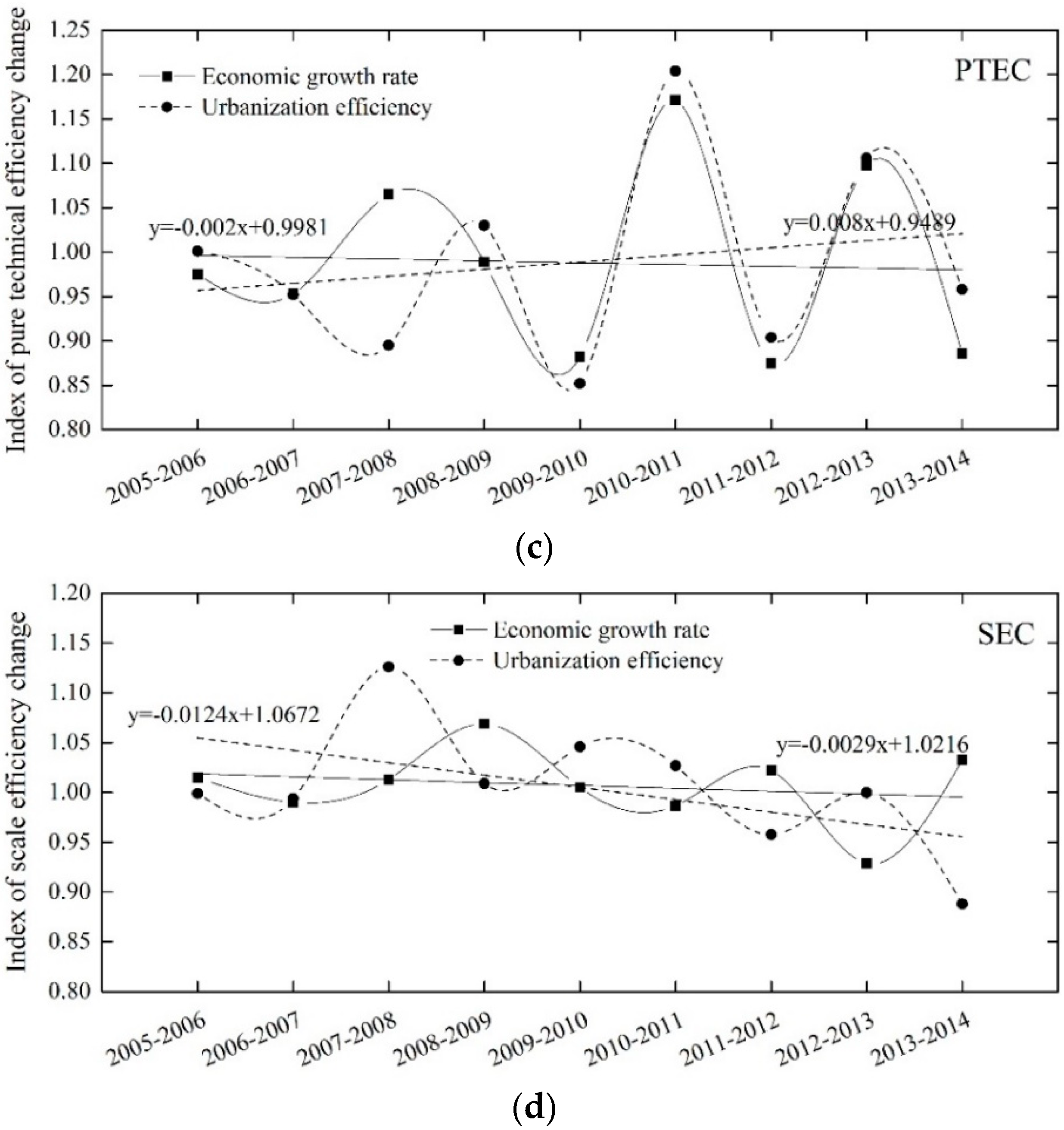
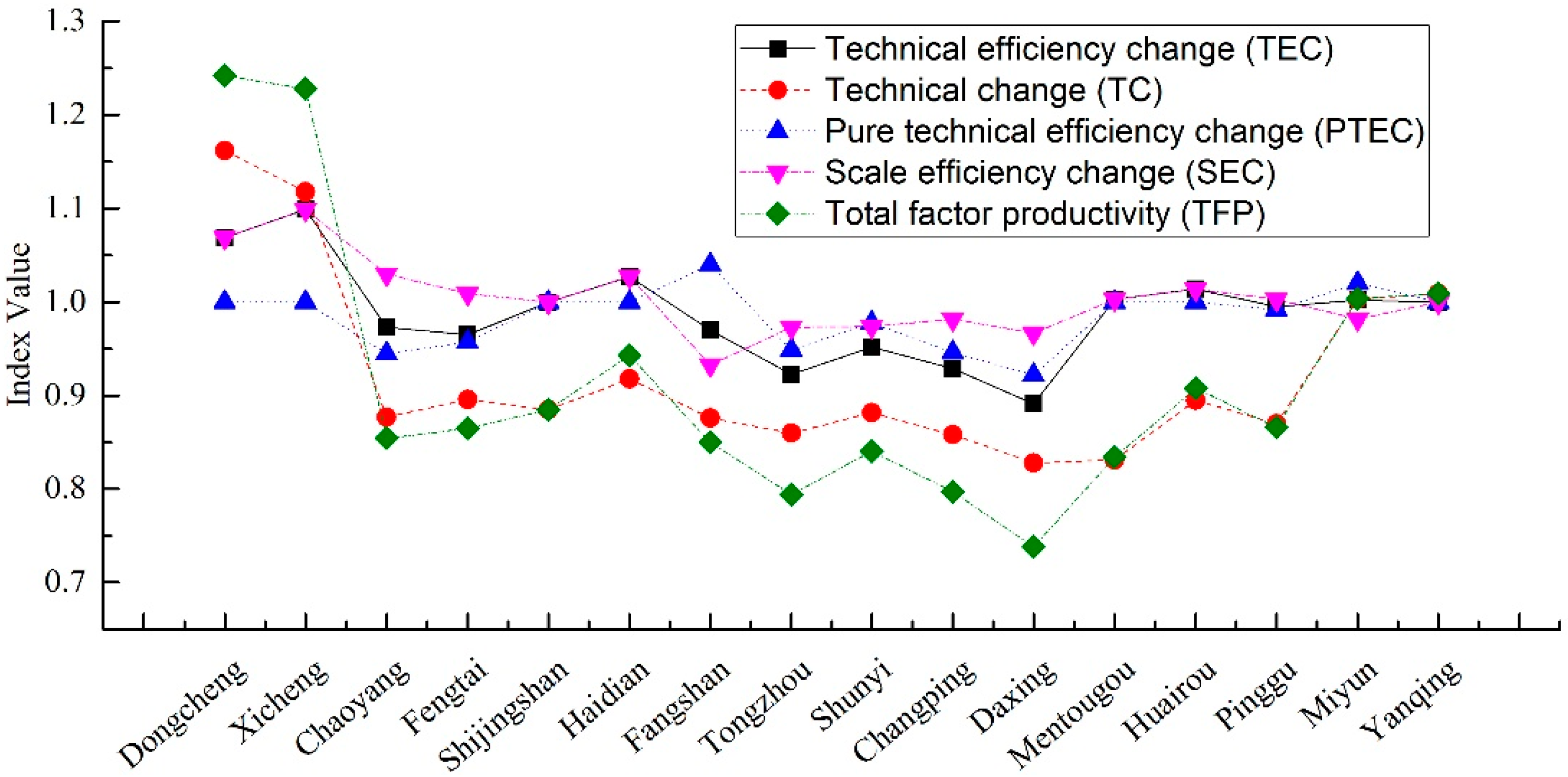
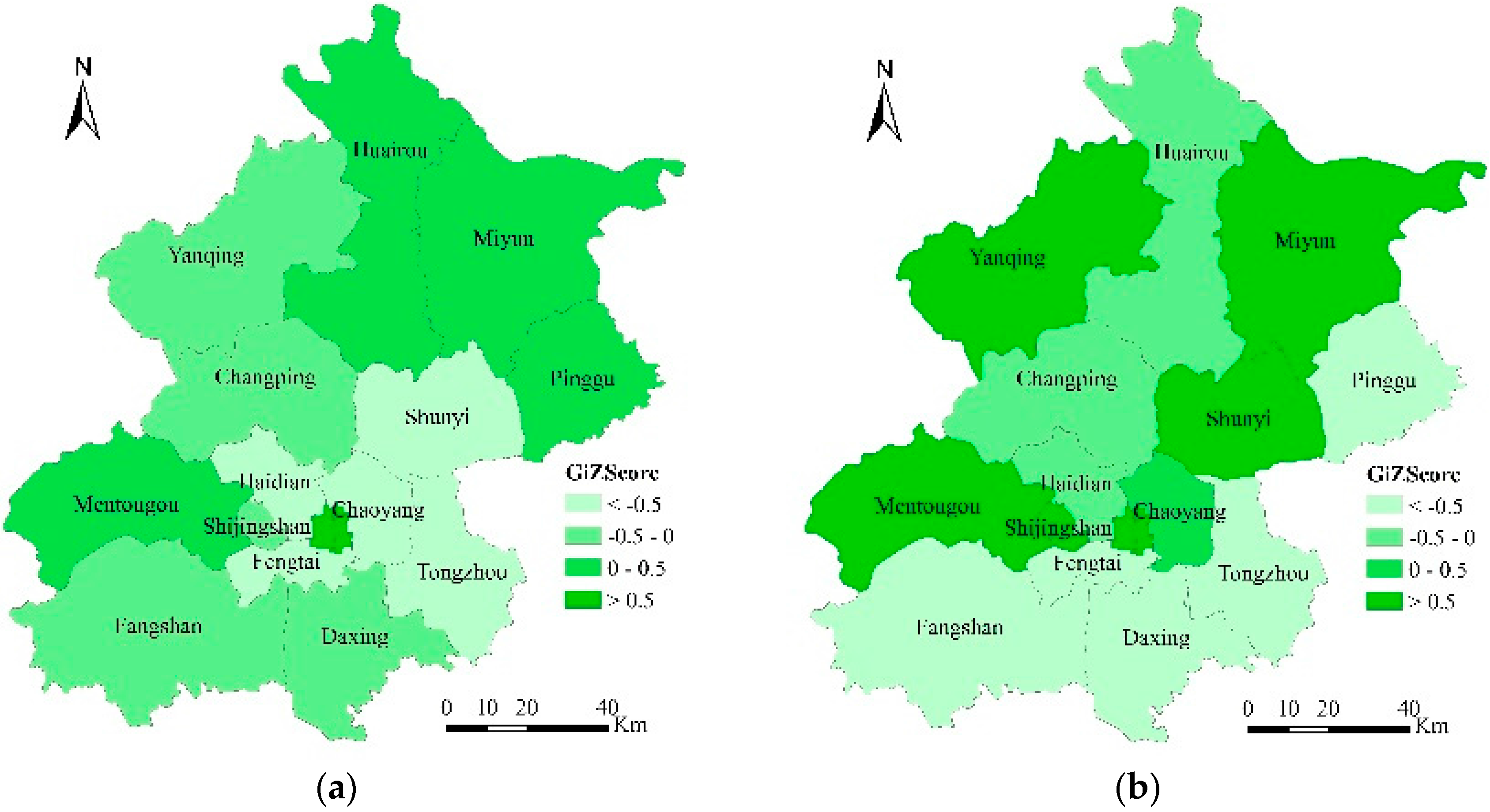
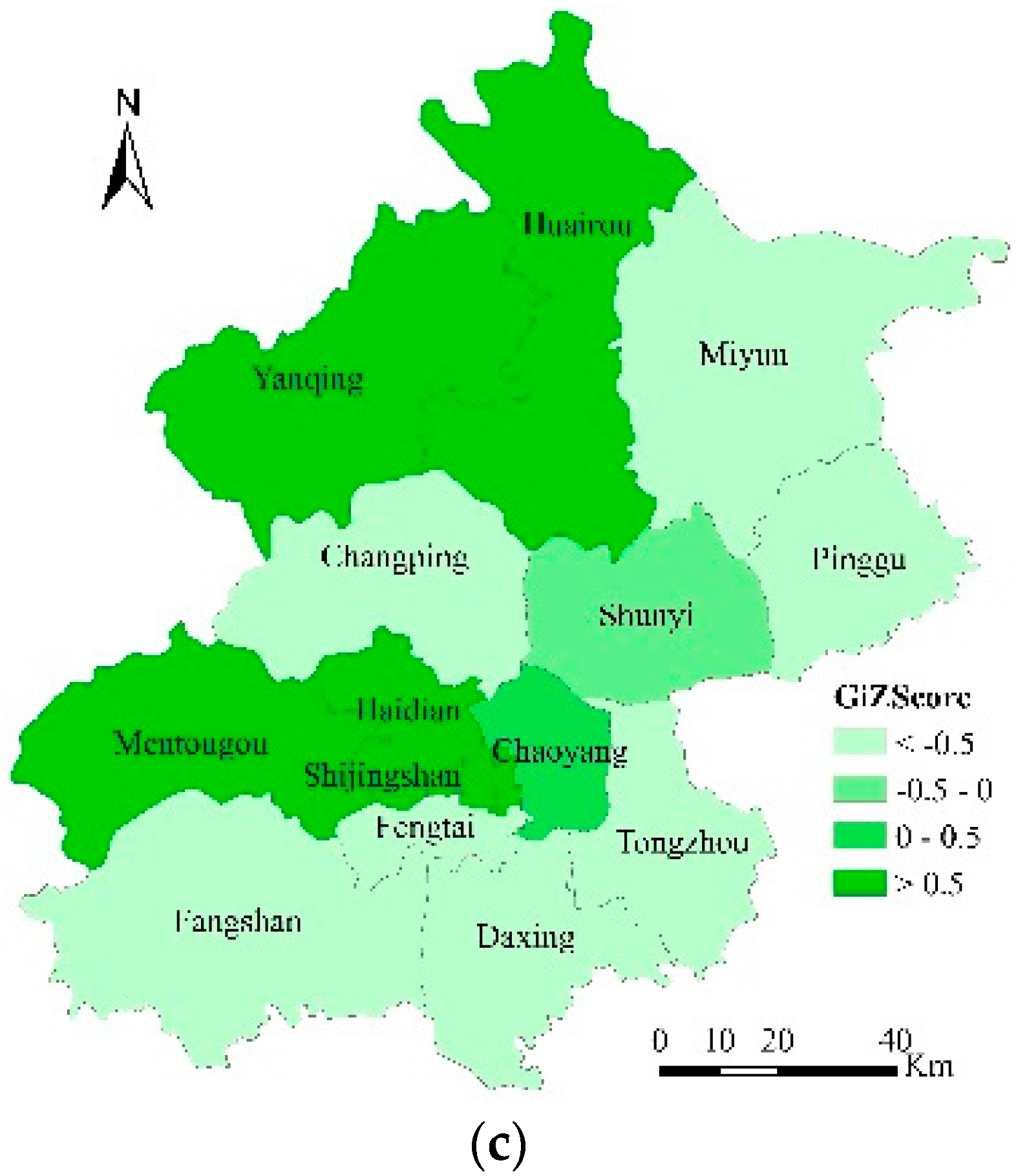
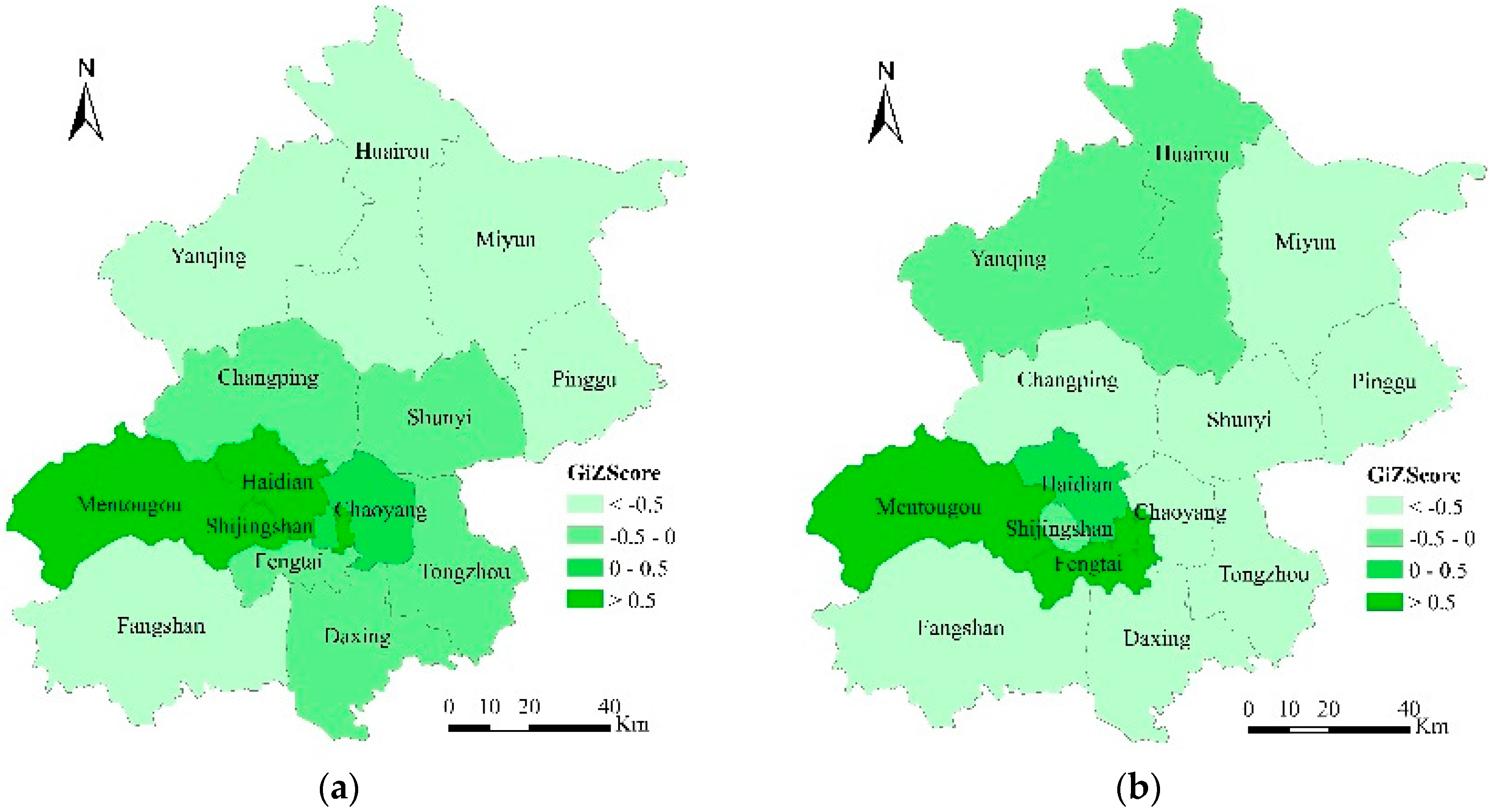
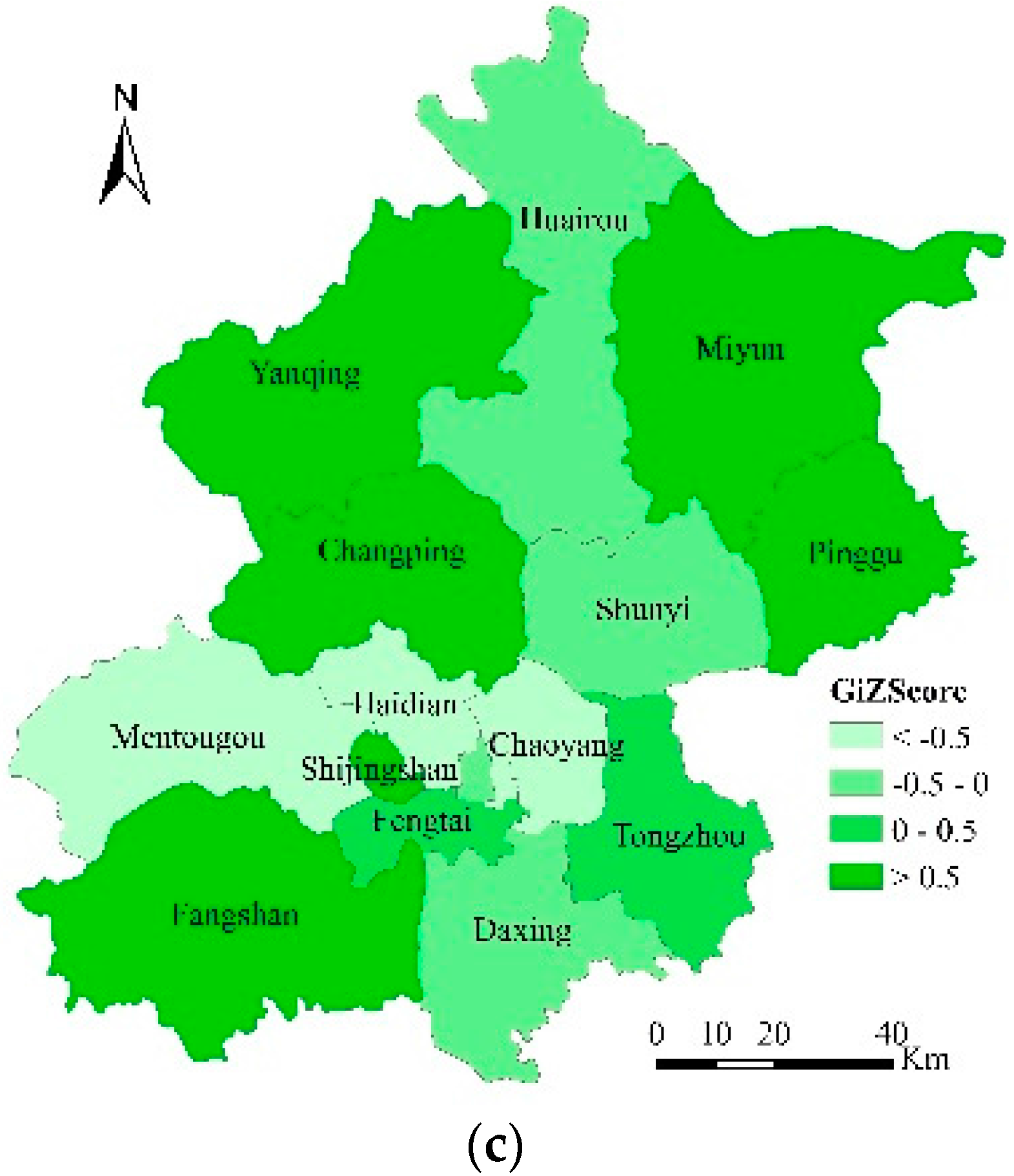
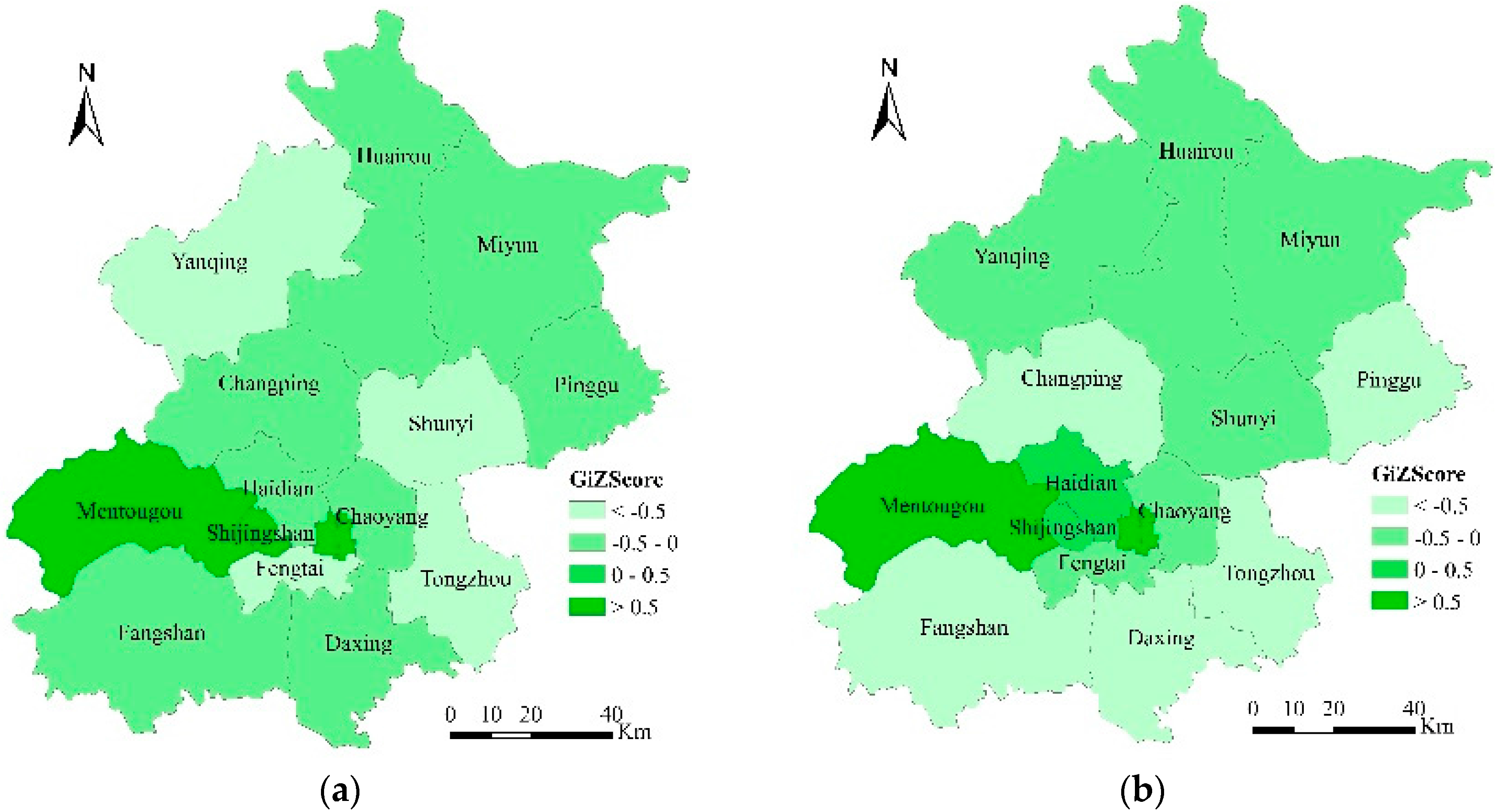

| Factor | Mean | Standard Deviation (SD) | SD/Mean | Maximum | Minimum |
|---|---|---|---|---|---|
| Floor space of constructed buildings (104 km2) | 251.797 | 20.008 | 0.079 | 1426.800 | 18.400 |
| Total investment in fixed assets (108 yuan) | 306.920 | 22.206 | 0.072 | 1235.441 | 16.700 |
| Foreign capital actually used (1010 USD) | 382.749 | 53.210 | 0.139 | 3900.110 | 0.820 |
| Employed persons (104 persons) | 39.158 | 3.106 | 0.079 | 164.415 | 3.983 |
| Financial expenditure (108 yuan) | 131.733 | 8.770 | 0.067 | 593.370 | 17.055 |
| Gross domestic product per capita (103 yuan/person) | 55.130 | 3.545 | 0.064 | 234.430 | 13.796 |
| Ratio of secondary industry and tertiary industry compared to gross domestic product (%) | 95.271 | 0.379 | 0.004 | 102.387 | 82.155 |
| Total retail sales of consumer goods (108 yuan) | 357.667 | 36.594 | 0.102 | 2377.633 | 12.844 |
| Type of Index | Index Constitution | Description of Input/Output Factors |
|---|---|---|
| Input factors | Floor space of constructed buildings | Land capital |
| Total investment in fixed assets | Material capital | |
| Foreign capital actually used | Foreign financial | |
| Employed persons | Human capital | |
| Financial expenditure | Financial capital | |
| Output factor for the economic growth rate | Gross domestic product per capita | Economic level |
| Output factor for urbanization efficiency | Ratio of secondary industry and tertiary industry compared to gross domestic product | Economic urbanization level |
| Total retail sales of consumer goods | Consumption level |
| Period | Capital Function Core (CFC) | Urban Function Development (UFD) | City Development Zone (CDZ) | Ecological Conservation Development Area (ECD) | ||||
|---|---|---|---|---|---|---|---|---|
| TFEE | TFUE | TFEE | TFUE | TFEE | TFUE | TFEE | TFUE | |
| 2005–2006 | 1.386 | 1.424 | 0.931 | 0.864 | 1.004 | 0.820 | 1.071 | 0.887 |
| 2006–2007 | 1.111 | 1.146 | 0.896 | 0.798 | 0.938 | 0.664 | 1.240 | 1.050 |
| 2007–2008 | 1.002 | 1.118 | 0.952 | 1.008 | 1.070 | 0.983 | 0.811 | 0.796 |
| 2008–2009 | 1.137 | 1.188 | 0.821 | 0.887 | 0.760 | 0.636 | 0.928 | 0.874 |
| 2009–2010 | 1.407 | 1.789 | 0.926 | 0.942 | 0.826 | 0.676 | 1.156 | 0.938 |
| 2010–2011 | 0.967 | 0.921 | 1.083 | 0.936 | 1.114 | 1.089 | 0.788 | 0.768 |
| 2011–2012 | 1.298 | 1.420 | 0.870 | 0.910 | 0.918 | 0.891 | 1.798 | 1.861 |
| 2012–2013 | 1.213 | 1.376 | 0.889 | 0.865 | 0.952 | 0.833 | 1.088 | 0.912 |
| 2013–2014 | 1.087 | 1.048 | 0.916 | 0.913 | 0.930 | 0.813 | 1.032 | 0.969 |
| District | Technical Efficiency Change (TEC) | Technical Change (TC) | Pure Technical Efficiency Change (PTEC) | Scale Efficiency Change (SEC) | Total Factor Productivity (TFP) |
|---|---|---|---|---|---|
| Dongcheng | 1.069 | 1.162 | 1.000 | 1.069 | 1.242 |
| Xicheng | 1.099 | 1.118 | 1.000 | 1.099 | 1.228 |
| Chaoyang | 0.973 | 0.877 | 0.945 | 1.030 | 0.854 |
| Fengtai | 0.965 | 0.896 | 0.957 | 1.009 | 0.865 |
| Shijingshan | 1.000 | 0.885 | 1.000 | 1.000 | 0.885 |
| Haidian | 1.027 | 0.918 | 1.000 | 1.027 | 0.943 |
| Fangshan | 0.970 | 0.876 | 1.040 | 0.933 | 0.850 |
| Tongzhou | 0.923 | 0.860 | 0.949 | 0.973 | 0.794 |
| Shunyi | 0.952 | 0.882 | 0.978 | 0.974 | 0.840 |
| Changping | 0.929 | 0.858 | 0.946 | 0.982 | 0.797 |
| Daxing | 0.891 | 0.828 | 0.922 | 0.967 | 0.738 |
| Mentougou | 1.003 | 0.831 | 1.000 | 1.003 | 0.834 |
| Huairou | 1.014 | 0.895 | 1.000 | 1.014 | 0.908 |
| Pinggu | 0.995 | 0.870 | 0.992 | 1.003 | 0.866 |
| Miyun | 1.002 | 1.003 | 1.020 | 0.982 | 1.004 |
| Yanqing | 1.000 | 1.009 | 1.000 | 1.000 | 1.009 |
| Mean | 0.987 | 0.918 | 0.984 | 1.003 | 0.906 |
| District | Comprehensive Efficiency (TEC) | Pure Technical Efficiency (PTEC) | Scale Efficiency (SEC) | Returns to Scale |
|---|---|---|---|---|
| Dongcheng | 1.000 | 1.000 | 1.000 | - |
| Xicheng | 1.000 | 1.000 | 1.000 | - |
| Chaoyang | 0.249 | 0.308 | 0.808 | drs * |
| Fengtai | 0.382 | 0.551 | 0.693 | drs |
| Shijingshan | 1.000 | 1.000 | 1.000 | - |
| Haidian | 0.300 | 0.391 | 0.767 | drs |
| Fangshan | 0.447 | 0.858 | 0.521 | drs |
| Tongzhou | 0.315 | 0.410 | 0.767 | drs |
| Shunyi | 0.342 | 0.439 | 0.778 | drs |
| Changping | 0.344 | 0.598 | 0.575 | drs |
| Daxing | 0.219 | 0.302 | 0.726 | drs |
| Mentougou | 1.000 | 1.000 | 1.000 | - |
| Huairou | 0.950 | 1.000 | 0.950 | drs |
| Pinggu | 0.756 | 0.764 | 0.990 | irs ** |
| Miyun | 0.696 | 0.846 | 0.822 | drs |
| Yanqing | 1.000 | 1.000 | 1.000 | - |
| Mean | 0.625 | 0.717 | 0.837 | - |
© 2017 by the authors. Licensee MDPI, Basel, Switzerland. This article is an open access article distributed under the terms and conditions of the Creative Commons Attribution (CC BY) license (http://creativecommons.org/licenses/by/4.0/).
Share and Cite
Qi, W.; Gao, Y.; Zhang, Q. Spatiotemporal Dynamics of Beijing’s Urbanization Efficiency from 2005 to 2014. Sustainability 2017, 9, 2190. https://doi.org/10.3390/su9122190
Qi W, Gao Y, Zhang Q. Spatiotemporal Dynamics of Beijing’s Urbanization Efficiency from 2005 to 2014. Sustainability. 2017; 9(12):2190. https://doi.org/10.3390/su9122190
Chicago/Turabian StyleQi, Wei, Ying Gao, and Qian Zhang. 2017. "Spatiotemporal Dynamics of Beijing’s Urbanization Efficiency from 2005 to 2014" Sustainability 9, no. 12: 2190. https://doi.org/10.3390/su9122190





